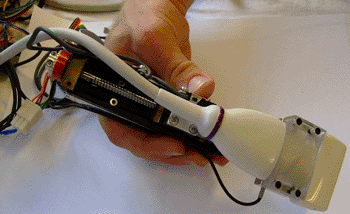Better Designed Ultrasound Could Improve Image Clarity
By MedImaging International staff writers
Posted on 26 Jun 2012
New ultrasound technology allows precise measurements and tracking of disease progression.Posted on 26 Jun 2012
New research conducted at the Massachusetts Institute of Technology (MIT; Cambridge, MA, USA) could improve the ability of untrained workers to perform fundamental ultrasound scanning, while allowing trained workers to much more effectively monitor the development of medical conditions, such as the accumulation of plaque in arteries or the growth of a tumor.

Image: The handheld, force-controlled ultrasound (Photo courtesy of MIT).
The improvements to this widely used technology could provide detailed information far beyond what is possible with existing systems, according to the researchers. The research, led by Dr. Brian W. Anthony, codirector of MIT’s Medical Electronic Device Realization Center (MEDRC) and director of the Master of Engineering in Manufacturing Program, was presented in May 2012 at the International Symposium on Biomedical Imaging in Barcelona (Spain).
There are two major features to the improvements engineered by Dr. Anthony and his team. First, the researchers developed a way to adjust for variations in the force exerted by a sonographer, generating more consistent images that can compensate for body motions such as breathing and heartbeat. Second, they provided a way to map the precise location on the skin where one reading was taken, so that it can be precisely matched with later readings to identify changes in the size or location of a tumor, clot, or other structure.
Together, the two improvements could make ultrasound a much more precise application for monitoring the progression of disease, according to Dr. Anthony. The devices are currently undergoing three clinical trials, including one at Boston Children’s Hospital (MA, USA) focused on monitoring the progression of patients with Duchenne muscular dystrophy (DMD).
In that trial, Dr. Anthony reported, researchers are trying to determine “how fast the muscle deteriorates, and how effective different medications are.” It’s important to have a reliable way of monitoring changes in muscle. The study is aimed at determining whether ultrasound imaging can serve as a convenient, noninvasive, clinically meaningful way of monitoring disease progression in DMD.
The new device maintains constant force through the addition of a force sensor to its probe tip and servomotors that can respond almost instantly to changes in force. That, in turn, makes it possible to examine how the image varies as the force increases, which can provide important diagnostic information about the elasticity of skin, muscle, and other tissues.
To provide accurate positioning, a tiny camera and lens mounted on the probe can reveal skin patterns that are distinctive and constant, similar to fingerprints. “Skin patterns are pretty unique,” Dr. Anthony said, the system, utilizing software to compare new images with earlier ones, “can get you back to that same patch of skin,” something that is impossible to do manually.
Dr. Anthony compares that precise positioning to “an on-the-patient global positioning system (GPS) system” for locating structures in the body. The ability to take images over time from exactly the same position makes it possible to monitor changing tissues quite precisely: The imaging system can determine the volume of a near-surface tumor or other feature to within an accuracy of 1%-2%, according to Dr. Anthony. There are existing ways to get this kind of accuracy, but these require expensive specialized equipment that few hospitals have.
Besides the potential for these sophisticated diagnostic capabilities, enhanced control over testing could make it possible for relatively untrained health care workers to administer basic ultrasound pregnancy tests--particularly in remote, underserved areas where trained sonographers may not be available. The various control methods “take the uncertainty out” of the process, Anthony says.
Dr. Craig Steiner, an anesthesiologist at Chester County Hospital (PA, USA), said, “I’m excited about the prospects” of these improved systems. “The reproducibility of the scan with consistent pressure and picture quality would help with remote readings of locally done scans. This could be relevant for teleradiology, which is an area ripe for expansion. The field of ultrasound is still developing. Ultrasound will partially replace CT scans, reduce radiation exposure to patients, and make diagnosing easier when away from the high-cost hospitals. It can help our world provide care at a more reasonable cost with a new paradigm of care.”
Related Links:
Massachusetts Institute of Technology














